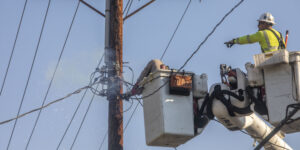Firms that scour social media sites such as Twitter for information to help investors and traders make money faced their biggest test yet this week.
A tweet reporting explosions at the White House appeared on the Associated Press’s official feed Tuesday afternoon, sparking a temporary sell-off that briefly wiped out about $140 billion in market value on the S&P 500.
The tweet was a fake and the account had been hacked. But for analytics firms that comb through tweets for tradable ideas—a small but growing niche industry—it was the latest example of the challenges they face in delivering information to a client base that often prizes speed first.
Failure to highlight a tweet saying President Barack Obama had been injured in an explosion would have left people in the dust as the market zoomed lower—but a hair-trigger response to sell may have been worse.
Some of these firms did throw up red flags, based on other tweets or on the unusual nature of the news, but the selloff had already happened. For some of the firms, that’s just fine – they’re aware of their limitations.
“The guys who trade on tweets as they happen will always be susceptible to things like this, that’s why we’ve shied away from delivering every tweet to people for them to trade off,” said Oli Freeling-Wilkinson, chief executive officer of the London-based analytics firm Knowsis, one of several recent start-ups which sell subscriptions to investors and institutions such as retail brokers and fund managers.
“Algorithms used to trade off news headlines, now they trade off tweets. That’s very dodgy, very shaky ground.”
For Knowsis and other firms doing this analytical work, the ability to discern news from noise is the key to success, and it appears to be getting harder. The U.S. Securities and Exchange Commission said earlier this month that companies can use Twitter, Facebook and other social media to make key announcements.
Tuesday’s fateful tweet appeared at 1:07 p.m. EDT (1707 GMT). It was picked up almost immediately by investors and analytic companies scanning Twitter for key words to determine breaking news or measure sentiment. Stocks and commodities moved sharply lower and bond prices soared.
Within minutes, analytics firm Dataminr issued an alert saying the AP account was probably hacked, citing another tweet by a reporter in the White House basement.
That warning came at 1:11 pm EDT, “just four minutes after the fake message had been published on the AP’s hacked Twitter account,” said Ted Bailey, New York-based chief executive ofDataminr, which was founded in 2009.
The difficulty of reacting to such news can be seen in this case, however. By the time Dataminr’s message went out, the market recovery was already underway.
The nature of the hoax created a challenge as the AP account is considered a trusted source. Past hoaxes originated from newly created accounts that were more readily identifiable as suspect. But the extraordinary nature of the news would have been another cautionary signal, some said, especially in the absence of similar reports by other news outlets.
“We would have published the AP tweet but because it could not have been verified at the time we would have clearly marked it as a rumor,” said Emmett Kilduff, chief executive officer at Eagle Intel in Dublin. “When it was proven to be false we would have published a note to our clients saying so.”
Kilduff, in an email, noted differences in the language of the fake tweet and official Associated Press style that could have outed it as a hoax, including the use of capital letters and that it referred to “Barack Obama” instead of “President Obama” or “Obama,” the two ways the AP refers to the president.
European markets were closed at the time of the hoax tweet.
The mini-crash sparked by the bogus tweet was reminiscent of the “flash crash” of May 2010 when security prices suddenly plunged, as if the floor had been yanked from underneath them.
The free-fall nature can be explained by a couple of factors. For one, automatic stop-loss orders, which are designed to limit an investor’s losses, kicked in, adding to the selling.
In addition, trading firms that provide liquidity pulled their bids, making the selloff more chaotic. Similar moves worsened the flash crash. In a market where participants step back when news is either onerous or uncertain, the combination of stop-loss orders and market makers withdrawing bids can make a selloff worse.
“We see this every time this type of news comes out: liquidity evaporates quickly. High-frequency traders cancel their orders on even one little tweet,” said Dennis Dick, a trader at Bright Trading LLC in Las Vegas.
Freeling-Wilkinson said analytics firms like his are more interested in looking at trends than individual tweets.
“I would never recommend that anyone trades on a single tweet,” he said.
(Additional reporting by Herb Lash; Editing by Claudia Parsons)




















 Significant But ‘Manageable’ Insurance Losses Expected From LA Fires: S&P
Significant But ‘Manageable’ Insurance Losses Expected From LA Fires: S&P  Insured Losses From Natural Disasters Hit $140B in 2024
Insured Losses From Natural Disasters Hit $140B in 2024  Tooker Takes President Role at The Hartford
Tooker Takes President Role at The Hartford  Mercury General Wildfire Losses Will Hit Reinsurance Cover. One Event?
Mercury General Wildfire Losses Will Hit Reinsurance Cover. One Event? 





